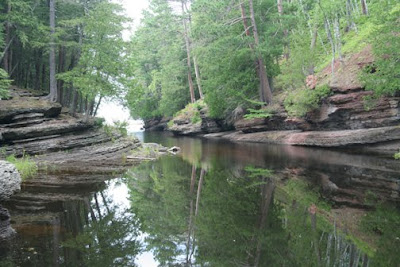There is something about the West that thrills me. Perhaps it's the idea that it's still the last frontier, the last wild place in America. It's a romanticized notion, I know, yet it clings to me. Images of snow-capped mountains, verdant valleys, pines and spruce and rocky streams make me giddy. If I believed in past lives I'd think I was Blackfeet or Cheyenne Indian, or an early pioneer. Perhaps it's my Swiss roots, yearning for Alpine peaks and meadows. Whatever the case, it was a thrilling vacation and I can't wait to go back.
We landed at the Jackson Hole, Wyoming, airport on a grey, rainy afternoon. We were hoping for spectacular views of the mountains from the plane but they were obscured in clouds. After picking up our rental car (a Subaru Outback Sport) we drove out to--where else?--the National Museum of Wildlife Art.
The drive along Highway 89 north out of Jackson Hole follows the Flat Creek for a time, seen here as a dark ribbon in the green field. This is National Elk Refuge territory, and in the winter this valley is filled with elk scraping their way through the harsh Teton winters, but in the middle of July the valley was empty.

The museum itself is a beautifully designed building, made with Arizona sandstone and built to match the topography. This sprawling complex houses a cafe and gift shop along with some of the most amazing wildlife art I have ever seen. The photo below is from their website.

Photos were not allowed inside the museum, but there were several sculptures outside so I snapped a few pics. Remember, this was pre-blogging days, and I was not so good at recording every little thing, so I didn't look to see who had done these pieces.
Works by Remington, Bateman, O'Keefe and others grace the museums walls, and I spent several hours wiping drool off my chin. I was awed by Robert Bateman's huge oil painting of a bull bison, titled "Chief". I don't know the exact size but it must be five long, very nearly life-sized. Bateman has been an inspiration of mine since high school, and to be in the presence of his original works was breathtaking.
 (This image was downloaded from a website selling prints.)
(This image was downloaded from a website selling prints.)We were staying two nights in the Tetons before heading to Yellowstone. We couldn't afford anything anywhere near Jackson Hole so we stayed at a Super 8 in Driggs, Idaho. This meant a hair-raising drive across the backbone of the Teton range on wet, unfamiliar roads being tailed by people who drove the route every day and were extremely impatient. I was white-knuckled all the way to the hotel.
.
We stopped at a grocery in Driggs to get "supplies" for our hike the next day, up into the Teton range along the Cascade Canyon trail. I could hardly sleep for the excitement!
.
Next: pronghorns, Jenny Lake and the Teton Mountains.

















































